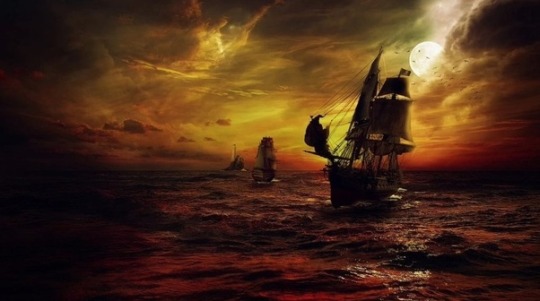#german antarctic expedition
Explore tagged Tumblr posts
Text

I love how it doesn't matter what expedition it is.
They all turn into excited kids when they meet penguins.

#the power of penguins#yeah the gifs are from the 1938/39 expedition#polar exploration#german antarctic expedition#don't ask me who is who i don't know it#but i do suspect its probably the flightcrew
21K notes
·
View notes
Text
Hey fellow polar exploration fan,
this Tumblr account is going to translate in the future the diaries of the Norwegian Sailor Paul Bjørvig, who participated in the first German Antarctic Expedition between 1901 and 1903 under Erich von Drygalski and participated again under Wilhelm Filchner's second German Antarctic Expedition (1911 -1913)
The German Translations of his Diaries were published in Reports of the Alfred Wegener Institut by Cornelia Lüdecke and we're translated from Norwegian to German by Volkert Gazert (the son of Hans Gazert who was a member of the first Expedition)
Disclaimer here: All rights to the original publication belong to the AWI, Cornelia Lüdecke and Volkert Gazert.
Download the German publication here https://epic.awi.de/57573/11/BzPM_0768_2022.pdf&ved=2ahUKEwjRuY20ud-KAxWsKvsDHfr2ENMQFnoECC0QAQ&sqi=2&usg=AOvVaw07OD285Pc9L8F67mParEXx
Also I need to mention I am not a professional translator!
The only reason I am doing this, is because I want people to be able to read about these expeditions and give awareness towards expeditions that some people might care less about because there is no or less English information available.
42 notes
·
View notes
Text

Account that the second expedition in the Deutschland was a literal embarrassment for Germany.
From the Duel challenges, to the alcoholic guy living in an igloo, to murder attempts, to a dead captain. Not all was probably known to the public at that time. But the expedition members coming home earlier and on different steamers was pretty saying already.
Not to mention Filchner's public duel challenge towards von Goeldel, the scientists not wanting to publish together etc
All that glossed over any achievements they still managed to get.
The Gauss Expedition actually went pretty well in comparison to that. But here Germany's Emperor wasn't happy that the Germans didn't even try to make any new record like Scott did.
In the end most countries who sponsored those expeditions had the sentiment of making demands to the land or at least breaking records and showing off which country is better.

reading about gauss expedition and it's pretty funny that everyone just forgot about this like damn. sorry you had a bad time. eehh anyways
#gauss expedition#german antarctic expedition#i am sure the world wars didn't do us any favor either in caring or remembering those expeditions#polar exploration
20 notes
·
View notes
Text
something so hilarious in going from "why is everybody so obsessed with cherry..." to opening worst journey and seeing this

like oh ok. tumblr target audience one way or another
#pax posts#polar exploration#apsley cherry garrard#the entirety of sara wheeler's 2003 intro really is something. it like weirdly touched me immediately#the worst journey in the world#ive been making my way through it slowly but rn i am commonplacing about for the first time👼🏻#rip german antarctic expeditions ive put on hold reading about for this
25 notes
·
View notes
Text







The German Antarctic Expedition, 1901-1903. Gauß Expedition
#polar exploration be damned. my men knew how to take pictures#gauss expedition#polar exploration#ph
179 notes
·
View notes
Text
9 TBRs for 2025









I was delighted to get tagged by the fabulous @burberrycanary! Thank you. <3
The Woman Upstairs by Claire Messud
The desire to read Messud's novel about an elementary schoolteacher who seems nice and calm on the outside but is secretly seething with anger and frustration on the inside was sparked by this post and a subsequent conversation with @village-skeptic about unlikeable female protagonists. I've been dying to read this for a while now, but it was surprisingly difficult to find in physical form (I'm sick of looking at screens all day and my library only had the ebook). Package tracking tells me it's finally due to arrive on January 10. I'm genuinely so very excited to read this!
Our Evenings by Alan Hollinghurst
This novel, which traces the life of a gay, biracial actor in England from the 1960s to the pandemic is only one example of a whole number of books* on my TBR about queer middle-aged men looking back on their lives and in the process delving into themes of personal growth, identity, and cultural and societal change. Wonder what that says about me as I approach middle age ever more rapidly myself? One can only speculate, of course...
*see also: Four Squares by Bobby Finger; My Ex-Life by Stephen McCauley; Caledonian Road by Andrew O'Hagan
Madhouse at the End of the Earth: The Belgica's Journey into the Dark Antarctic Night by Julian Sancton
Not much to say about this except that my thirst for books about doomed (Ant)arctic expeditions has apparently still not been quenched. I guess this is my version of True Crime. This has made several Best-of lists, so I hope that it'll be well-written (and edited!) too, which is not always a given with nonfiction books.
The Winter Soldier by Daniel Mason
The assumption is an obvious one to make, but no, this has nothing to do with the #1 Blorbo of my heart. This is actually a novel about a young medical student from Vienna thrown into a remote WWI field hospital, where he soon leaves behind any romantic notions about glory and heroism as he faces the brutal reality of war. I've read the first 50 pages of this a while ago, and I'm really eager to get back to it.
Effingers by Gabriele Tergit
This 1951 novel is often described as the "Jewish Buddenbrooks"—a comparison that I understand for marketing purposes but that I nevertheless do not like for a whole host of reasons. It’s an epic, multigenerational story about a German-Jewish family from the late 19th century through WWII. I got a beautiful special hardcover edition of this for Christmas and I can't wait to savor all 904 pages of it.
Secret City: The Hidden History of Gay Washington by James Kirchick
Speaking of long books. I bought this 848-page brick of a political and social history of queer (not exclusively gay as the misleading title would suggest) Washington at the height of my Fellow Travelers obsession... and then I just never got around to reading it. A failure that I really want to make up for this year.
Daddy by Emma Cline
I already very much liked but did not unreservedly love Emma Cline's debut The Girls. However, I was completely blown away by her follow-up novel The Guest, which she published last year, and which instantly catapulted her to auto-buy status for me. So, it's only natural that I would want to read the only book of hers that I haven't read yet. Daddy is a short story collection, which will hopefully deliver the same sharp observations, wonderfully complex characters, and elegant & precise prose that I have adored so much in her novels.
The Warm Hands of Ghosts by Katherine Arden
To be honest, the premise of this—historical fiction with supernatural elements, following a combat nurse during WWI searching for her missing brother—does not super excite me (anything magical realism-adjacent has traditionally not been a great success for me) and reviews seem to be pretty mixed. But. Katherine Arden is the author of my beloved Winternight Trilogy*, so I will at least give this a fair chance.
*seriously I want to grab all the Romantasy girlies and shove this into their hands instead of whatever latest abomination Cassandra Clare or Sarah J. Maas have cooked up. ...uh, sorry if you're a fan? 😬
Manhattan Beach by Jennifer Egan
I read and enjoyed Jennifer Egan's Pulitzer Prize-winning novel A Visit from the Goon Squad many years ago and have been meaning to read another book by her ever since. When a couple of my family members asked what I wanted for Christmas and I put together a little list for them (cause that's what I do), I stumbled upon Manhattan Beach. It's a blend of historical fiction, mystery, and family drama set in Depression-era New York City, about a young woman who pioneers as the first professional female diver at the Brooklyn Navy Yard. Does that not sound like the perfect book for me? Seriously, the summary reads like I made it up in fever dream!
--
Looking back over this list, I'm somewhat surprised to realize that it gives the impression that I'm much more of a historical fiction reader than I actually am. Or thought myself to be, I guess. Huh! How about that.
Ok tagging: @ethicalhorseslaughter, @burninblood, @thisonesatellite, @between-a-ship-and-a-hard-place, @voylitscope, @aimmyarrowshigh, @weenhand, @painted-doe, @buckrogers, @maplefiasco and everyone else who wants to do this! Show me your books, please.
(I know this has been making the rounds, so apologies if I double- or triple-tagged anyone.)
33 notes
·
View notes
Text
Queer book recs from IFM's editors
Mantha's Rec(s)


Lynn Flewelling's Nightrunner Series and Tamír Triad
Any chance Mantha gets they recommend Lynn Flewelling's Nightrunner Series and Tamír Triad. Both set in the same world but in two different eras, these fantasy series have become so dear to them over the years.
The Nightrunner books are part fantasy, part political intrigue, part murder mystery, all while exploring themes of belonging and identity. And while they don't have genders outside the binary, the two main characters are bi, cis men (with a little gender-nonconformity in there, too.)
The Tamír Triad tells the coming of age story of a trans girl at court in the midst of political upheaval: think Knights of the Round Table but King Arthur is trans.
Flewelling's writing is impeccable. She has a gift for character, detail, and setting that creates immersive worlds. Though not recent publications - the first book came out in 1996 - they were the first books Mantha read that showed them that the sky was truly the limit in fantasy writing.
Lydia's Rec

All the White Spaces by Ally Wilkes
Not for the faint of heart, All the White Spaces by Ally Wilkes is a historical thriller in which a trans man stows away on an expedition ship bound for the Antarctic from England.
Set just after WWII, the stakes are quickly raised when the ship - the only way the expedition is getting home - is destroyed just shy of their destination. Missing most of the crew and nearly all their supplies, the few remaining members of the expedition must find a way to survive the winter in Antarctica.
Stumbling across a German expedition's camp seems like a stroke of good luck - but where did the Germans go (and would they even believe the war was over?), and what lurks in the darkness just outside of the lamp light?
Sione's Rec

Life Ceremony by Sayaka Murata
If you're a short story reader who loves weird, slightly dark speculative fiction (think George Saunders, Miranda July, Alexander Weinstein, Carmen Maria Machado), Sione highly recommends Sayaka Murata's book of short stories, Life Ceremony, which came out in paperback in May.
While the stories don't contain genders outside the binary, there is gay rep, asexual and aromantic spectrum rep, and neurodiversity rep.
But what really gets zir excied about this book are the themes! This is basically an entire short story collection about what's normal, who decides, and how changeable our social norms and taboos are, which opens a window into a future with many queer and neurodivergent possibilities. Ze hasn't been this excited about a new book in a very long time.

Originally published in our newsletter on July 31st, 2023.
#inclusivefuture#magazine#nightrunner series#nightrunner#lynn flewelling#tamír triad#tamir triad#all the white spaces#ally wilkes#life ceremony#sayaka murata#book recs#book recommendations#queer books#queer lit#queer book recs
71 notes
·
View notes
Text
The Piri Reis Map

Piri Re'is
The Piri Reis Map, one of several enigmatic maps drawn in the 15th Century and earlier, presents a puzzle. It holds more accurate information about the shape of the continents than should have been known at the time, sparking intrigue and curiosity.
The Piri Reis map, created by Ottoman-Turkish cartographer Ahmed Muhiddin Piri in 1513, has attracted significant attention due to its depiction of an ice-free Antarctic coastline. If this is true, someone had discovered and mapped Antarctica centuries before its reported discovery in 1773. This revelation challenges our understanding of history and raises intriguing questions about the capabilities of ancient civilizations. Could they know the world is only known to modern science, such as the structure and function of DNA, or advanced astronomy and physics?

The Piri Reis Map is only one of several strange maps drawn in the 15th Century and earlier, and it appears to represent better information about the shape of the continents than should have been known at the time. In 1929, Director Halil Edhem went through the basement of a Turkish palace looking for old maps at the request of German theologian Gustav Adolf Deissmann. Edhem happened upon a very mysterious artifact. A small map was inked onto animal skin, although only a fragment remained. At first, it looked like any other aged map. However, upon closer inspection, something caught Deissmann's attention. It was ultimately identified as the Piri Reis map, incorporating the only known copy of Christopher Columbus' map.
The Piri Reis map is one of the cornerstones of the growing body of evidence for an unknown Ice Age civilization. This civilization existed during the last glacial period, leaving intriguing artifacts and mysteries behind. The Piri Reis map, with its accurate depictions and advanced cartographic techniques, is a testament to this civilization's knowledge and capabilities.
The Piri Reis map showed Antarctica's coastline and the proportions of the continent without its ice cap, which were only visible over 6,000 years ago. Our modern knowledge of the coastline under the ice was obtained using seismic-sounding data. This technique involves sending sound waves into the ground and measuring the time it takes to bounce back from Antarctic expeditions in the 1940s and 50s.

This data allowed us to map the coast under the Antarctic glaciers. The other way to map these coastlines would be to have surveyed them when they were ice-free. According to Hapgood, who based the claim on 1949 core samples from the Ross Sea, the last time the particular area shown in the Piri Reis map was free of ice was more than 6000 years ago. More recent studies show that this may be off by a couple of magnitude. In any case, this geography should have been unknown to the ancients. If this is correct, there are some big mysteries to explain.
In 1965, Professor Charles Hapgood from the University of New Hampshire and his students scrutinized the Piri Reis map. They were not only intrigued by its depiction of the Antarctica coastline but also by another peculiar anomaly. The map had been created using the Mercator Projection, a method of map-making that allowed for a more accurate curvature when transferring maps from paper to globe. This was a technique that European cartographers didn't adopt until 1569, making the Piri Reis map a testament to advanced cartographic techniques that were seemingly ahead of their time.
Hapgood concluded that a civilization with high seafaring and mapping skills surveyed the entire Earth in the ancient past. They left maps that have been copied by hand through many generations. The Piri Re'isRe'is map is a patchwork with gaps (most notably the Drake Passage between South America and Antarctica) that can be explained as non-overlapping areas between the source maps. Maps of the Ancient Sea Kings. Based on what we know, ancient civilizations needed the tools or capabilities to map continents on such a grand scale. Do you know how it could have been achieved? Scholars and historians began to speculate. Paranormal researchers pointed to some extraterrestrial assistance. Others hypothesized the possible involvement of a civilization based around the Lost City of Atlantis. Does the map show an ice-free Antarctica from over 6,000 years ago? Is it proof that an alien technology once existed on Earth?
#aliens#history#science#ufology#mytholog#religions#space#news#writers on tumblr#conspiracy theories#conspiracies#ancient history#forbidden knowledge#truth reading#truthrevealed
4 notes
·
View notes
Text
Events 1.17 (before 1946)
38 BC – Octavian divorces his wife Scribonia and marries Livia Drusilla, ending the fragile peace between the Second Triumvirate and Sextus Pompey. 1362 – Saint Marcellus' flood kills at least 25,000 people on the shores of the North Sea. 1377 – Pope Gregory XI reaches Rome, after deciding to move the Papacy back to Rome from Avignon. 1524 – Giovanni da Verrazzano sets sail westward from Madeira to find a sea route to the Pacific Ocean. 1562 – France grants religious toleration to the Huguenots in the Edict of Saint-Germain. 1595 – During the French Wars of Religion, Henry IV of France declares war on Spain. 1608 – Emperor Susenyos I of Ethiopia surprises an Oromo army at Ebenat; his army reportedly kills 12,000 Oromo at the cost of 400 of his men. 1641 – Reapers' War: The Junta de Braços (parliamentary assembly) of the Principality of Catalonia accepts the proposal of establishment of the Catalan Republic under French protection. 1648 – England's Long Parliament passes the "Vote of No Addresses", breaking off negotiations with King Charles I and thereby setting the scene for the second phase of the English Civil War. 1649 – The Second Ormonde Peace creates an alliance between the Irish Royalists and Confederates during the War of the Three Kingdoms. The coalition was then decisively defeated during the Cromwellian conquest of Ireland. 1773 – Captain James Cook leads the first expedition to sail south of the Antarctic Circle. 1781 – American Revolutionary War: Battle of Cowpens: Continental troops under Brigadier General Daniel Morgan defeat British forces under Lieutenant Colonel Banastre Tarleton at the battle in South Carolina. 1799 – Maltese patriot Dun Mikiel Xerri, along with a number of other patriots, is executed. 1811 – Mexican War of Independence: In the Battle of Calderón Bridge, a heavily outnumbered Spanish force of 6,000 troops defeats nearly 100,000 Mexican revolutionaries. 1852 – The United Kingdom signs the Sand River Convention with the South African Republic. 1873 – A group of Modoc warriors defeats the United States Army in the First Battle of the Stronghold, part of the Modoc War. 1885 – A British force defeats a large Dervish army at the Battle of Abu Klea in the Sudan. 1893 – Lorrin A. Thurston, along with the Citizens' Committee of Public Safety, led the Overthrow of the Kingdom of Hawaii and the government of Queen Liliʻuokalani. 1899 – The United States takes possession of Wake Island in the Pacific Ocean. 1903 – El Yunque National Forest in Puerto Rico becomes part of the United States National Forest System as the Luquillo Forest Reserve. 1904 – Anton Chekhov's The Cherry Orchard receives its premiere performance at the Moscow Art Theatre. 1912 – British polar explorer Captain Robert Falcon Scott reaches the South Pole, one month after Roald Amundsen. 1915 – Russia defeats Ottoman Turkey in the Battle of Sarikamish during the Caucasus Campaign of World War I. 1917 – The United States pays Denmark $25 million for the Virgin Islands. 1918 – Finnish Civil War: The first serious battles take place between the Red Guards and the White Guard. 1920 – Alcohol Prohibition begins in the United States as the Volstead Act goes into effect. 1941 – Franco-Thai War: Vichy French forces inflict a decisive defeat over the Royal Thai Navy. 1943 – World War II: Greek submarine Papanikolis captures the 200-ton sailing vessel Agios Stefanos and mans her with part of her crew. 1944 – World War II: Allied forces launch the first of four assaults on Monte Cassino with the intention of breaking through the Winter Line and seizing Rome, an effort that would ultimately take four months and cost 105,000 Allied casualties. 1945 – World War II: The Vistula–Oder Offensive forces German troops out of Warsaw. 1945 – The SS-Totenkopfverbände begin the evacuation of the Auschwitz concentration camp as the Red Army closes in. 1945 – Swedish diplomat Raoul Wallenberg is taken into Soviet custody while in Hungary; he is never publicly seen again.
0 notes
Text
Grytviken, South Georgia Island. Dec. 24-26, 2024. Part 4.

Anytime we were within sight of land. Penguins and fur seals frolicked around the ship. Here is an action shot of a penguin shooting out of the water and about to reenter.

After leaving Port Stanley, we spend two days at sea traveling to South Georgia Island. The Captain opened up the bridge for guests to see. We attend multiple lectures each day to kill the time.

We do another bio-security check of our outer clothes during sea days. Here Expedition guide Giuliano, from Peru, double checks our gear. We will have a make or break inspection by the South Georgia Official when we get to Grytviken. If they find a few to many deviations we will not be allowed to land. The future of this ship coming back this season is also in jeopardy. While we are responsible for our clothes, the expedition guides are deep cleaning all 150 pairs of our boots in the mud room.

Nancy enjoying the hot tub after her sauna.

One afternoon there was a special on the aft deck of hot Asian soup. The poor server has to wear a Antarctic jacket to stay warm out here.

If you spend enough time on deck you will see Humpback whales exhaling steam (see center of photo). We could see up to 4 whales at a time a half mile away.

More hors d’oeuvres just to help get us to dinner. These are quickly followed by champagne.

Christmas eve at sea.

Fur seal welcoming us to the old Norwegian whaling station Grytviken.

As we pull in to Grytviken the Albatross Expedition ship pulls out. These ships are tightly controlled on when and where they can bring passengers.

This is Grytviken. 1.6 million whales were killed in the Southern Ocean between 1904 and 1986, this being one of the primary whaling stations. Over 100,000 Humpbacks were killed. The Humpback whale population just about collapsed in 1960’s. The population was down to 5,000 when whaling stopped. Now it is back to 135,000.

Our landing site will be to the right of the derelict ships between the blue barrels. There are three large fur seals at the site. The expedition guides had to keep them at bay. We are not allowed to get within 15 feet of the animals if possible. Sometimes they walk up to and between us. If they charge you, you throw up your arms or clap. They usually stop, then slowly back down….usually!

Here are two of the derelict whaling vessels. These carried huge harpoon cannons on the bow. They would tie up to 8 whales to the sides and tow them back for processing.

This is the museum with whale bones, harpoon guns and anchors on display in the front yard. Laying among the displays are fur seals.

Here is a large fur seal scratching an itch.

Two pups and an adult fur seal hanging out. The babies are usually crying out to be heard by their mom. It is very noisy where fur seals congregate.

Nancy walking to the Norwegian Church built in 1913. It had been prebuilt in Norway. Disassembled, then transported to Grytviken in pieces. Originally known as “The Whalers Church.” It was a Norwegian Lutheran Church.

The inside was decorated for Christmas. The front door was propped open with a heavy harpoon head.

In the back left was a library complete with book check out cards. Would love to see what the actual books were. I assume many are Ships logs.

A private sailboat was tied up to the dock. A lone German sailor onboard, preparing to sail to South Africa. Temperature today is a high of 40 F, so the parkas are needed.

Juvenile King penguins still molting their feathers. They can not go swimming until all the feathers are dropped. There is a lot of squawking going on here. The white things on the ground are their feathers.

Nancy in the Grytviken cemetery. Even though there is a fence around it, the baby fur seals get under the fence and hang out. As with most early Christen cemeteries, the graves face easterly to receive the second coming of Christ. There is one grave in the back with a large headstone and it faces 90 degrees to all the others. That is the final resting place of Sir Earnest Shackleton, of Antarctic expedition fame.
There are 64 graves, mostly whalers. The earliest graves are from the sealers in the very late 1890’s. In 1982 a POW Argentine submariner, Felix Artuso, was buried here. He was shot during the Falkland invasion on a submarine in the harbor. Basically due to language differences.

Sir Earnest Shackleton’s grave. He died in South Georgia on his third expedition to the Antarctic in January, 1922. His head is towards the South Pole where his heart lies.
Nov. 2011 the ashes of Commander Frank Wild were buried to the right of Shackleton’s grave. The inscription is, “Frank Wild 1873-1939, Shackleton’s right hand man.” Wild died two weeks before WW2 broke out. His ashes were lost until recovered in a crypt in Johannesburg, by an author writing a book about him.
Talking to some of our ship’s officers they talk about visiting these two graves as often as they can, to pay their respects to such legendary seafarers.

Fur Seal pups are everywhere.

As are King Penguin juveniles. You can see the white feathers on the grass where they have molted.


These are the tips of the Harpoons. The modern Harpoon gun was invented in 1864 by the Norwegian Svend Foyn. These tips would have a grenade between it and the shaft. On impact a glass vile of sulfuric acid would shatter and set off the grenade.

This is where the blubber would be boiled down. The whalers could completely carve up a 40 foot whale on the slipway in 20 minutes.

We wade in the water to loosen any bio matter from our boots. Then the Expedition guides scrub the bottom of our boots before we board the zodiac. Unfortunately we did observe several dead elephant and fur seals. Which emphasizes the importance of the bio security measures.

Back to the ship. This was one of the top two places we stepped ashore. Mostly because of the associated history. It was also our first time walking around the penguins and seals.
0 notes
Text
Today's selected anniversaries: 10th May 2024
1833:
Siamese–Vietnamese wars: Lê Văn Khôi escaped from prison to begin a revolt against Emperor Minh Mạng, primarily to avenge his adoptive father, Vietnamese general Lê Văn Duyệt. https://en.wikipedia.org/wiki/L%C3%AA_V%C4%83n_Kh%C3%B4i_revolt
1916:
Ernest Shackleton and five companions arrived at South Georgia, completing a 1,300 km (800 mi) lifeboat voyage over 16 days to obtain rescue for the Imperial Trans-Antarctic Expedition. https://en.wikipedia.org/wiki/Voyage_of_the_James_Caird
1940:
World War II: German forces commenced their invasion of Belgium. https://en.wikipedia.org/wiki/German_invasion_of_Belgium_%281940%29
2013:
One World Trade Center in New York City, the tallest building in the Western Hemisphere, was topped out at a height of 1,776 feet (541 m). https://en.wikipedia.org/wiki/One_World_Trade_Center
0 notes
Text




Sailors of the Gauss Expedition (1901 - 1903)
(that's only like half of the crew, but not all have solo shots in von Drygalski's book)
#hurray to the low quality#i am sorry guys i only got low quality photos of them#german antarctic expedition#polar exploration#gauss expedition
28 notes
·
View notes
Text
31.1.1902 Fresh wind from the NW.
We took 35 dogs and 14 puppies on board. 10 remained on Kerguelen. At 10 a.m. we were ready and set off. When we cleared the land we steered SSW.
2 notes
·
View notes
Text
Hold my non alcoholic beer, let me add to the shows (as a lazy ass Person, I shall copy paste from an old reddit post I made)
\~ Nautical theme \~
° War Sailor - Norwegian Netflix series about Merchant Sailors during WW2 - 4 Episodes
° Greyhound - Movie about an Atlantic Convoy during WW2
° Britannic - Movie that's very loosely based on the sinking of the HMHS Britannic
° Shattered City - The Halifax Explosion - Movie based on the Halifax Explosion cause by the ships Mount Blanc and Imo during WW1
° Master and Commander - Napoleonic War at sea, ost people have heard of that movie probably eitherway already
° Black Sails - 4 seasons of Pirates doing what pirates do best, do I need to say more?
° In the Heart of the Sea - Movie based on the Essex disaster
° Horatio Hornblower (several Movies) - pre-napoleonic war at sea
° Die Gustloff - German TV Production, based on the sinking of the MV Wilhelm Gustloff during WW2
° Die Männer der Emden - German TV production about the Journey of the crew of the SMS Emden during WW1
° To the Ends of the Earth - Jared Harris is captaining here again
°Der Untergang der Lusitania - German movie about the sinking of the Lusitania in WW1
\~ Cold Boys aka Polar Expeditions \~
° Nova Zembla - Dutch TV production about a Expedition in 1598 to find a North East Passage
° Shackleton - British TV production about Shackleton's failed Imperial Trans Antarctic Expedition
° Against the Ice - about two men that were left behind in Greenland during a danish expedition
° Amundsen - Roald Amundsen his life cut together into a Movie
° The North Water - the classic recommendation for The Terror fans, about a whaler that sinks in arctic and the crew trying to survive
° Arctic Convoy - Norwegian Netflix Movie about the Arctic Convoy during WW2
° Shackleton's Captain - docudrama that tells a different side of Shackleton's Imperial Trans Antarctic
° Flight of the Eagle - about Andrée's Arctic balloon expedition of 1897
° The last place on Earth - about the Race between Scott and Amundsen to the South Pole, it shows both sides
° The journals of Knud Rasmussen - Never found this movie, so from Wikipedia: "The film is about the pressures on traditional Inuit shamanistic beliefs as documented by Knud Rasmussen during his travels across the Canadian Arctic in the 1920s."
° Scott of Antarctica - Movie from the late 40s, about Scott his Terra Nova Expedition, some of the actual members of the Expedition actually saw this movie still
° Titina - Kids movie that follows Umberto Nobilles dog Titina
°The Worst Journey in the World - BBC docu-drama based on Cherries book
° The Greeley Expedition - it's a documentary, you can find it on YouTube
° Pionier der Arktis - Jean Baptiste Charcot - German documentary about Charcot (it's on YouTube but without subtitles)
°The Icebreaker - Russian movie about an icebreaker stuck on an iceberg
°Mission: Arctic - Russian movie about the polar explorer Bering
\~ There is Ice? \~
°Norwand (North Face) - German TV production about two mountaineers who tried to climb the Eiger North Face
°So weit die Füße tragen (As far as my feet will carry me) - German Movie about a German prisoner of war fleeing from a gulag and trying to find his way home through the cold of siberia
°Joyeux Noel (Merry Christmas) - movie about the Christmas Truce in 1914
\~ It has some ice and a ship \~
° Titanic - who hasn't heard of this one?
° A Night to remember - Titanic but approved by actual survivors
(There are more titanic movies, but I left it at the two best versions)
And an adventure movie that has a ship but no cold
° The incredible journey of Mary Bryant - about a woman who gets forcefully shipped to Australia for stealing bread, and her long way back to England again
I don't know if that List will help anybody, but here we are, also I am sure some of the movies are a far grab.
Oh also there is the first hand footage from terra nova, endurance and the Fram and the 20 more Shackleton movies I forgot about
I've been working on putting together something fun!
The current categories are: nonfiction books, fiction books, poetry, games/3d environments, music, and web resources. At present the nonfiction section is the beefiest, cobbled together from various tumblr posts (including one showing the research shelf of The Terror's writers' room!).
This is intended to be a living, crowd-sourced document. Please feel free to submit additions, comments, and questions via Tumblr asks or messages.
233 notes
·
View notes
Text

ᛉ NAZI UFOS ᛉ
Fact or fiction?
During World War II, Germany developed an interest in flying saucers, and an airport hangar in Prague was dedicated to research into their development. However, it is propertied that none of these experiments ever found their way off the ground - quite literally.
Several sources describe theories of Nazi association with the extraterrestrial.
The book “Le Matin des Magiciens” (1960) by Louis Pauwels and Jacques Bergier claimed that the Vril Society, a perhaps fictional secret society that would have served as a sort of inner circle of the Thule Society, made contact with extraterrestrial life and dedicated it’s cause to creating a UFO to reach these aliens. The book purports that the Vril Society worked with the Nazi Party to develop early prototypes of flying saucers. However, with the Nazi defeat, the group is said to have fled into a secret base in Antarctica, where they retreated into the Hollow Earth to meet with an advanced race that inhabited the inside of the planet.
German fascist writer Ernst Zündel claimed in his books that flying saucers were secret weapons developed by the Nazis in a secret underground base in Antarctica, and with this technology, the Nazis sought to conquer Earth and eventually the planets. This very well could have been a B.S. claim by Zündel however, as he is recorded as claiming that this was a hoax, and also charged an absurd $9999 dollars a seat for an expedition to find the Hollow Earth entrance in Antarctica that Pauwels and Bergier spoke of.
In his book, “The Golden Thread: Esoteric Hitlerism”, Chilean writer and diplomat Miguel Serrano incorporates the theories of Savitri Devi into the canon of Nazi UFO theories. Serrano suggests that Hitler, as an avatar of Vishnu, was in communication with ancient Hyperborean gods in, again, an underground Antarctic base. Serrano predicted that Hitler planned to lead a lead a fleet of UFOs from the base to establish a Fourth Reich.
Regardless of the more extravagant claims of these sources, one question remains: what happened in Antarctica?
0 notes
Text
i learned that the Nazis believed strongly in the myth of Atlantis. Under the guidance of Heinrich Himmler, archeologists spread the idea that Germans were descended from a superior race of Antlanteans. The Nazis believed Atlantis was located under the Antarctic ice and made expeditions there. (x)

136 notes
·
View notes